
 Gatka is becoming popular amongst Sikhs and non-Sikhs in the West. Raveena writes that this resurgence in the Toronto area is primarily because of The Annual International Yudh Gatka Tournament that originated in Toronto in 2003. This year the tournament is being held in New Jersey. The Toronto leg of the tournament will on August 23rd the Rexdale Gurdwara Sahib. You can find out more information at Yudh.net.
Gatka is becoming popular amongst Sikhs and non-Sikhs in the West. Raveena writes that this resurgence in the Toronto area is primarily because of The Annual International Yudh Gatka Tournament that originated in Toronto in 2003. This year the tournament is being held in New Jersey. The Toronto leg of the tournament will on August 23rd the Rexdale Gurdwara Sahib. You can find out more information at Yudh.net.
Why is Gatka becoming so popular? Yudh.net writes that, “Not only does Gatka emphasize the physical training of martial arts, but it puts a special focus on ‘mental’ training which is needed to be successful in any sport”. Thus, this traditional Sikh martial arts from the early 17th century is a place to relieve stress, heighten awareness, but also learn sportsmanship and respect-for both people and weapons.
For those of you who attend the Tournament, please let us know how it goes.
 The US Congress is on their August recess and most have returned to their home constituencies. The atmosphere throughout the country is becoming increasingly polarized over the issue of healthcare. From Palin’s stupidity in labeling Obama’s plans “downright evil” (I almost don’t know what is worse – her attempt to ‘inflame’ sections of the public through such incendiary language or the fact that she is still unaware that there is NO “Obama plan” – Obama has left the process to the branch of the government that is suppose to make laws – the Congressional legislative branch) to Obama’s call for sanity and an end to “outlandish” claims against the process, the partisan hackery has already begun.
The US Congress is on their August recess and most have returned to their home constituencies. The atmosphere throughout the country is becoming increasingly polarized over the issue of healthcare. From Palin’s stupidity in labeling Obama’s plans “downright evil” (I almost don’t know what is worse – her attempt to ‘inflame’ sections of the public through such incendiary language or the fact that she is still unaware that there is NO “Obama plan” – Obama has left the process to the branch of the government that is suppose to make laws – the Congressional legislative branch) to Obama’s call for sanity and an end to “outlandish” claims against the process, the partisan hackery has already begun.
So now I open up a discussion here in The Langar Hall. What we are going to attempt to do is what, unfortunately, is not happening in the rest of the country – an honest discussion. Instead, we have had partisan hacks yelling “Socialism” and others yelling “Fascism” with divisions based on well-known party allegiances, rather than real interests. Will we be successful in The Langar Hall?
Healthcare has been discussed before, but as the topic is taking center stage in the United States, it is an opportunity to use our community capital. In the United States, Sikhs are far over-represented in health services. From doctors to nurses to physical therapists and everything else, we occupy a broad expanse of the health care sector. What are our opinions on health care? What are the opinions of our brothers and sisters from UK, Canada, India and other countries, which have very different systems?
We are seeing how political power is harnessed and used by the Sikh community as we engage in more civic engagement projects initiated by our own Sikh institutions. Civic engagement is not new to our community per se. The first Asian congressman was a Sikh-Dalip Singh Saund. As a child I remember local Sikh business leaders and professionals brought governmental representatives to our Gurudwaras to give speeches. These politicians were later recogonized with a saroopa and more opportunities to address their Sikh constituency at mela award ceremonies that seemed to last longer than the actual musical performances. Often these politicans were talking in English to a community that primarily understood Punjabi. It seemed more like an opportunity for the local Sikh leaders to secure their political connections for their own business interests than really an opportunity to hold politicians accountable to meeting their Sikh constituency’s needs. These political connections were often rooted in the capacity of the Sikh “leaders” to donate money than actually represent the needs of the Sikh community in a sustained way. I don’t want to paint this picture with too broad of a brush stroke because there are some Sikh business leaders, professionals, and activists who did build political power in our community to meet our needs; but they are definitely a minority. These Sikhs pushed along despite all the obstacles of being immigrants, They should serve as inspiration for the new generation of Sikh activists. This new generation needs to remember that we are not breaking as much untouched ground as we sometimes think we are doing. Our work should attempt to build off of those who came before us.
Coblogged by Camille and Reema
This week is Energy and Environment week. The environment has been front page news for a while now and one Sikh group is getting involved. 
Recently, SCORE launched a new initiative called EcoSikh, a project driven towards promoting environmentalism and environmental stewardship particularly in Punjab, but in the Sikh community at large. EcoSikh is the Sikh contribution to a larger project between the UNDP and the Alliance for Religions and Conservation (ARC, a UK-based NGO). UNDP and ARC are funding many religious communities to develop plans and ideas to integrate environmental consciousness into their members’ communities and personal behavior.
The program plans to work through 5 areas it has identified as: assets (using existing skills, time, resources for environmental projects), media/advocacy, eco-twinning (developing relationships of mutual benefit between various Sikh communities by sharing environmental ideas), celebration, and education. Each of the 5 program areas has been rooted in Sikh theology as a reminder of the historic import and connection with the environment in the Guru’s bani. A draft of the plan can be found here.
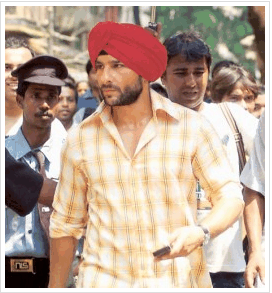 I’ll admit…Bollywood movies were boycotted and banned in my household as far back as I can remember, so maybe these “religious sensitivity pre-screenings” are common…but the course of events surrounding this new movie is still quite strange…even for Bollywood’s standards.
I’ll admit…Bollywood movies were boycotted and banned in my household as far back as I can remember, so maybe these “religious sensitivity pre-screenings” are common…but the course of events surrounding this new movie is still quite strange…even for Bollywood’s standards.
Last week, a new movie titled “Love Aaj Kal” was released, with Saif Ali Khan playing a Sikh as the lead male role. However, shortly before the release, the Punjab Cultural and Heritage Board objected to his portrayal of a Sikh.
Explaining their stand, Charan Singh Sapra, President of Punjabi Cultural And Heritage Board informed a tabloid, “We are objecting on the grounds that Saif is shown with a very trim beard.”
Long story short, after Khan’s formal apology and a paparazzi-filled press conference at Guru Singh Sabha Gurdwara, Dadar – 15 seconds of a questionable scene was cut from the movie and Khan declared he would not portray a Sikh “incorrectly” again in future roles. All smiles, the Punjabi Cultural And Heritage Board gave the movie “two thumbs up” and the green light to proceed.
I guess I should be happy that an organization is concerned enough about the image of Sikhs to raise such a fuss…except for the fact that we’re talking about fantasy-land. My question is…where is the organization that cares about the Sikh image in real life?
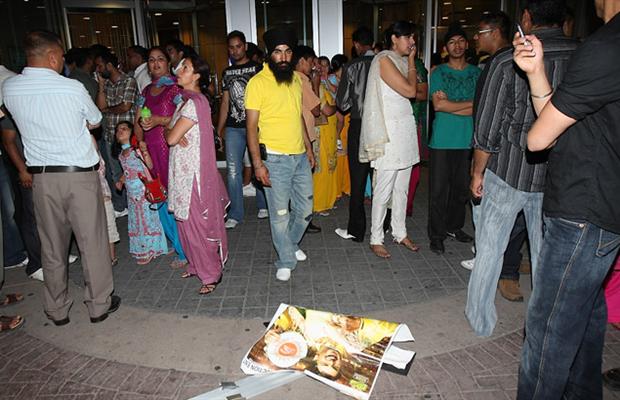 For diasporic Sikhs, it seems routine and almost expected to wake up to news about an incident where a Sikh was banned access to an event because of his or her kirpan. Many times, we blame this on the ignorance of law enforcement, who often have never heard of a kirpan. We tell ourselves, “Don’t worry, we just have to teach them and they’ll understand.” However, when Kirpan wearing patrons at a Gurdas Mann concert are barred entry, then we must stop for pause.
For diasporic Sikhs, it seems routine and almost expected to wake up to news about an incident where a Sikh was banned access to an event because of his or her kirpan. Many times, we blame this on the ignorance of law enforcement, who often have never heard of a kirpan. We tell ourselves, “Don’t worry, we just have to teach them and they’ll understand.” However, when Kirpan wearing patrons at a Gurdas Mann concert are barred entry, then we must stop for pause.
When a kirpan wearing citizen is blocked access from exercising their civil liberties, we as a community go into uproar mode. We file lawsuits, organize protests, and launch mass public marketing campaigns in order to exercise what we believe to an unalienable right and an articulation of our personal sovereignty. When a Bollywood movie comes out with a Sikh hero sans beard, our institutional bodies outrun and out-leap each other to be the first to cry foul. When a Baba in a Dera dresses up as Guru Gobind Singh Ji, we bring the state of Punjab to a halt.
However, at the point where cultural icon and repository Gurdas Mann, goes so far as to write “No Kirpans or Sharp Objects Allowed” on tickets being sold at a VAISAKHI show in England, then what do we do? We let him carry forward and WE outrun and out-leap each other so we can be first in line at his next concert.
Now when his concert bans an entity which is legally allowed in the public spaces of Canada, then what do we do? Do we ignore and slowly sweep this incident under the rug, like so many of our cultural problems? Or, do we stop and say, Hey, standing next to K.P.S Gill and lambasting “Sikh terrorism” is not ok; banning kirpans in UK is not appreciated; and throwing out concertgoers in Alberta, is simply no longer going to work.
With so few details, it may be premature to begin writing some thoughts, but that hasn’t really stopped me before.
Although each incident has its own genesis, with the recent spate of shootings this week, a discussion forum is needed. First I begin with an analysis of various Indian media coverage and then shift to a broader discussion then just the two events.
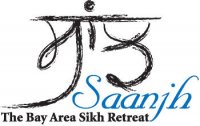
“Saanjh”-the annual Bay Area Sikh Retreat is taking place Thursday, August 27th-Sunday, August 30th at the Monte Toyon campsite near Santa Cruz, California. Share your experiences and connect with other Sikhs through a Guru-inspired sangat. This year’s theme is “Developing a Panthic Vision Towards 2084”. In 2009 we commemorate the 25th anniversary of 1984. When we fast-forward to its centennial where do we want to be as a Panth-a Sikh community? What is our collective vision for 2084? How do we need to develop as individuals and a community in order to heal ourselves and find solutions to our communal problems? Come share your opinions and connect with other concerned Sikhs through a collaborative approach to finding solutions. You will be inspired by diwans, conversations, debates, and laughter. Register by August 3rd to avoid late fees. There is a separate fee schedule for students and professionals. For more information visit www.saanjh.org. If you have any questions, e-mail sawal-jawab@saanjh.org.
As way of background, “Saanjh” began last year by a group of Bay Area Sikhs who were inspired by their personal experiences of engaging with sangats world-wide. They felt there was a need in California to “retreat” from our daily routines into a relaxed space where we could be inspired by our Guru. With this inspiration we could go back to our “real” lives as better engaged Sikhs spiritually, socially, and politically. The focus of the retreat is on learning from our experiences as diverse Sikhs in order to develop a collective vision for our community.
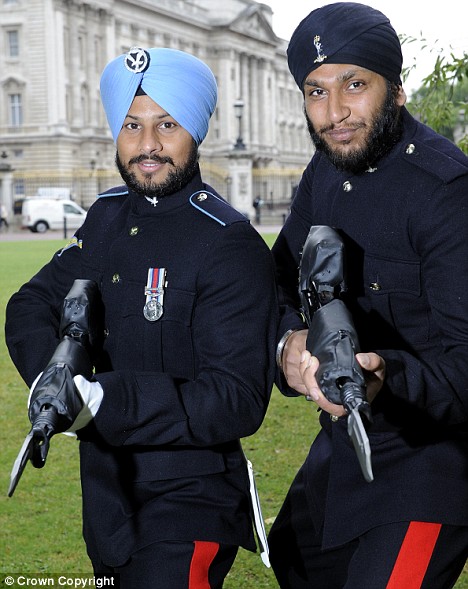 I was very impressed to see this great article (and cool pic!) in today’s Daily Mail. Along similar lines as last week’s post on the Blue Beret Kanhaiyas, it is wonderful to see Sikhs presented in this light…as confident and courageous soldiers in highly respected positions. Equally fascinating are some of the comments to the article which seem to be coming from mostly non-Sikhs, such as “Her Majesty is in safe hands with those two guarding her” and “Very smart they look too.” This is a far cry from the hate you’ll find on some of the military websites and blogs regarding the Sikh Coalition’s “Right To Serve” campaign. I hope this milestone and media attention of the Queen’s new guards will help serve as a stepping stone in this historic campaign here in the US.
I was very impressed to see this great article (and cool pic!) in today’s Daily Mail. Along similar lines as last week’s post on the Blue Beret Kanhaiyas, it is wonderful to see Sikhs presented in this light…as confident and courageous soldiers in highly respected positions. Equally fascinating are some of the comments to the article which seem to be coming from mostly non-Sikhs, such as “Her Majesty is in safe hands with those two guarding her” and “Very smart they look too.” This is a far cry from the hate you’ll find on some of the military websites and blogs regarding the Sikh Coalition’s “Right To Serve” campaign. I hope this milestone and media attention of the Queen’s new guards will help serve as a stepping stone in this historic campaign here in the US.
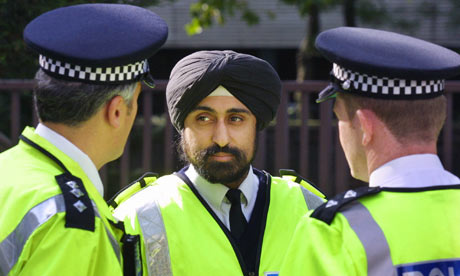 Sikh victims of crime will now be given the option of requesting a Sikh police officer to work on their case. Well, in London at least. The goal of this new service, offered by the Metropolitan Police, is to make use of the “special” knowledge officers have in regards to Punjabi culture to help address issues such as forced marriage and honor crimes. Many police officers believe that crimes have gone unreported and unsolved within the Punjabi Sikh community due to a lack of cultural understanding by police officers from a “white” background.
Sikh victims of crime will now be given the option of requesting a Sikh police officer to work on their case. Well, in London at least. The goal of this new service, offered by the Metropolitan Police, is to make use of the “special” knowledge officers have in regards to Punjabi culture to help address issues such as forced marriage and honor crimes. Many police officers believe that crimes have gone unreported and unsolved within the Punjabi Sikh community due to a lack of cultural understanding by police officers from a “white” background.
Palbinder Singh, chairman of the Metropolitan Police Sikh Association (MPSA) said: “It’s about understanding and appreciating difference. I don’t believe a white officer is ever going to be fully conversant with a Sikh for example. We have got evidence in the most serious type of crimes where Punjabi culture itself is the issue, that they haven’t been properly investigated.” [link]
Cringe.
When the British Sikh Police Association (BSPA) was set up, a spokesman suggested that the organization represented an important move towards social cohesion and integration, just like ‘other support networks within the police’. The BSPA did an excellent job at setting up an online service to allow women to report honor-based violence. It’s a completely valid effort to address the needs of minority communities – and something which should be celebrated. However, while I am a huge advocate for providing culturally and linguistically relevant services in all public sectors, I’m not sure that the solution proposed by the Metropolitan Police in England is necessary a good thing. Instead of providing diversity training to all members of the police force, this policy divides justice across ethnic lines.
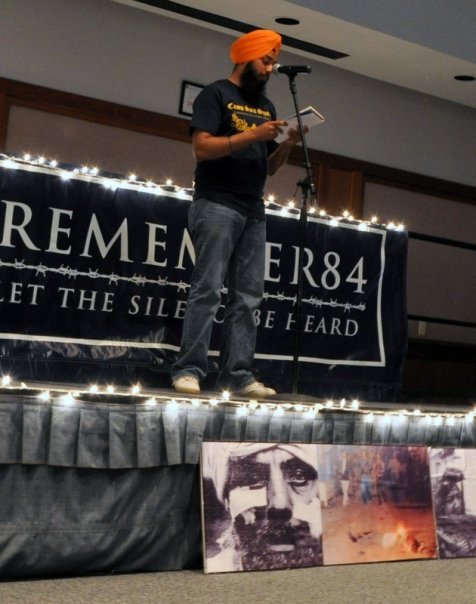 This past Saturday night, twenty artists from all over the country took to the mic in front of a packed and energetic crowd at the University of Maryland for Lahir 2009. It was a powerful evening of remembrance and reflection to commemorate the 25th anniversary of the 1984 Sikh Holocaust, organized by the DC Sikh Youth.
This past Saturday night, twenty artists from all over the country took to the mic in front of a packed and energetic crowd at the University of Maryland for Lahir 2009. It was a powerful evening of remembrance and reflection to commemorate the 25th anniversary of the 1984 Sikh Holocaust, organized by the DC Sikh Youth.
It was amazing to see teenagers, college students, young professionals, and even a few parents take to the stage and share their thoughts and reflections about 1984, human rights, and justice. Not only did the performers span across generations, but the performances themselves ranged in art form from musical pieces, poetry, and spoken word.
For me, it was fascinating to see how different each of the performers connected with 1984 – early in the show one artist eloquently recited an excerpt from Sirdar Kapur Singh’s 1966 speech to parliament, another tied environmental issues and water rights to 1984, while others shared personal accounts, poetry, dharmik geets, and dhadi vaaran. Regardless of how different each artist connected to 1984…the connection itself was strong…and watching that unfold on stage was absolutely breathtaking!
The evening concluded with G.N.E performing some of their recent tracks in front of their hometown audience. Seeing uncles and aunties “waving from side to side” was definitely a sight to remember.
A nice piece in the Columbia Journalist discusses the challenges incurred by young Sikh men and women as they navigate through their adolescent years. The article tells us of two friends, Sonu Singh and Manjinder Singh, who have bonded over their love of hip-hop, video games, and (of course) girls. However, as the article notes, what sets these friends apart is the fact that while Manjinder chooses to keep his kesh, Sonu plans to grow his hair and wear a pagh later on in life.
Sonu and Manjinder embody a larger tension within the Sikh community – the internal dilemma among children to remain true to their faith while still fitting in with their peers. After the terrorist attacks of September 11, 2001, some Sikhs simply do not want to stand out. Incidents of harassment and discrimination towards Sikhs students have increased dramatically since then…
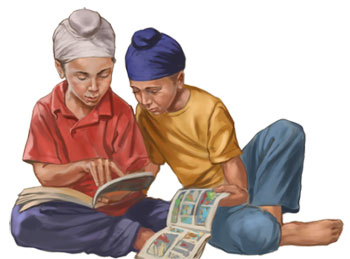 The article talks about the various cases of harassment and bullying which have taken place in New York City schools. The Sikh Coalition has stated that almost half of students who wear paghs have experienced physical violence in school. Yes, half! While bullying affects children of all ethnic groups, it is clear that Sikh children feel especially vulnerable. In addition, many young Sikh children don’t feel that they are adequately equipped to deal with harassment targeted at their physical appearance.
The article talks about the various cases of harassment and bullying which have taken place in New York City schools. The Sikh Coalition has stated that almost half of students who wear paghs have experienced physical violence in school. Yes, half! While bullying affects children of all ethnic groups, it is clear that Sikh children feel especially vulnerable. In addition, many young Sikh children don’t feel that they are adequately equipped to deal with harassment targeted at their physical appearance.
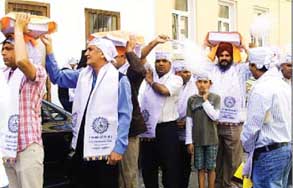 Beyond brown or white Sikhs, beyond various caste Sikhs, when and how do we come together as Sikhs? Is the ‘jahaaz’ that is Guru Nanak’s Naam large enough to carry us all, or with a narrow set of doxies and praxis do we restrict those that can enter.
Beyond brown or white Sikhs, beyond various caste Sikhs, when and how do we come together as Sikhs? Is the ‘jahaaz’ that is Guru Nanak’s Naam large enough to carry us all, or with a narrow set of doxies and praxis do we restrict those that can enter.
Despite the various attacks on the Singh Sabha movement for only promoting Khalsa hegemony and other spurious slanders by neo-Sanatans, post-colonialists (I am reminded of a professor that once told me that he would only become a post-colonialist, when colonialism ends) attempting to form neo-Brahman ‘intelligentsias’, those that believe they ‘own’ the Sikh identity, some Hindu chauvinist groups, and various beatniks, the movement was in fact very broad-minded and fought to enlarge the tent that is the Sikh Qaum.
They understood the difference between public and private aspects. In private, people may have their own practices, beliefs, etc. and while the Singh Sabha sought to bring these more in line with the practices and principles of Gurbani, they did allow some diversity in private. In public, we come together and stand by the Panthic rehat maryada.
For many years the Ravidasia, occupied such a place. They had distinct practices in their own places of congregation, but they were part of the larger Sikh Qaum. That was until now.
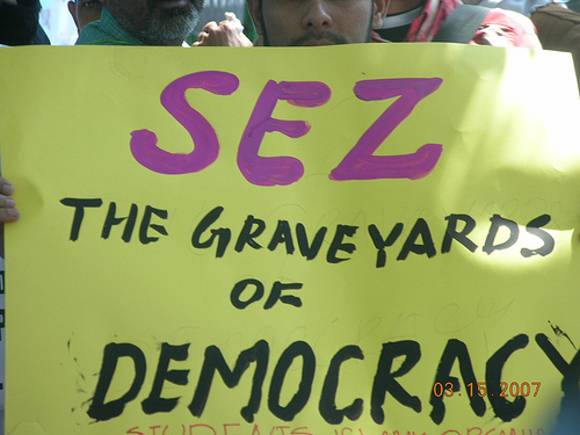 Earlier this month TLH discussed how the unseasonably dry summer in Punjab is threatening its agriculture and economy. This week, the Punjab Assembly adopted a resolution authorizing the development of additional Special Economic Zones, or SEZs, while streamlining and supporting the existence of pre-existing SEZs.
Earlier this month TLH discussed how the unseasonably dry summer in Punjab is threatening its agriculture and economy. This week, the Punjab Assembly adopted a resolution authorizing the development of additional Special Economic Zones, or SEZs, while streamlining and supporting the existence of pre-existing SEZs.
SEZs are not entirely new to Punjab. In 2006, Punjab cleared thirteen (13) SEZs for development and approval, and the proposal was approved by the Indian central government in 2007. The current number of “greenlit” SEZs in Punjab currently totals 12, but the number could increase extensively.
 The list of 1984-inspired Sikh propositions continue to grow. In the past, I have mentioned more than my fair share and last week my fellow langa(w)r-iter added one more. Here is another great proposal.
The list of 1984-inspired Sikh propositions continue to grow. In the past, I have mentioned more than my fair share and last week my fellow langa(w)r-iter added one more. Here is another great proposal.
This year marks the the creation of two great scholarships by the Jakara Movement. One aimed at high schoolers: “Bhai Amrik Singh Scholarship for Excellence” and the other at junior/community college transfers: “Bibi Upkar Kaur Scholarship for Excellence.” In this 25th year of commemoration of the 3rd Sikh Genocide (Ghallughara), these are the institutions that will last. The Scholarships provide national recognition and financial support for students, who exhibit outstanding academic strength as well as exceptional service to Sikhs and the American community at large.
The organizers describe them:
In honor of two pioneers of Sikh activism, Bibi Upkar Kaur and Bhai Amrik Singh’s exemplary dedication to the Sikh community are illustrated by their association with Sikh student organizations. Both were presidents of their respective Sikh student organizations and lived by their convictions of striving for excellence through dedication and perseverance in all aspects of their lives. Both applied this conviction to their educational pursuits, being accomplished students, and supportive of other students in pursuing academic excellence and achievement as well. They believed that as Sikhs, students had the obligation to not only excel in education, but also to carry the responsibility of being of service to the community. Bibi Upkar Kaur and Bhai Amrik Singh gave their lives for this very cause. Hence, these distinguished awards reflects Bibi Upkar Kaur and Bhai Amrik Singh’s legacies of commitment to academic excellence and service to the Sikh community as well as the greater community at large.
Early last week, a remarkable thing happened. Sikh children took to NYC streets again- some in strollers- and they were heard.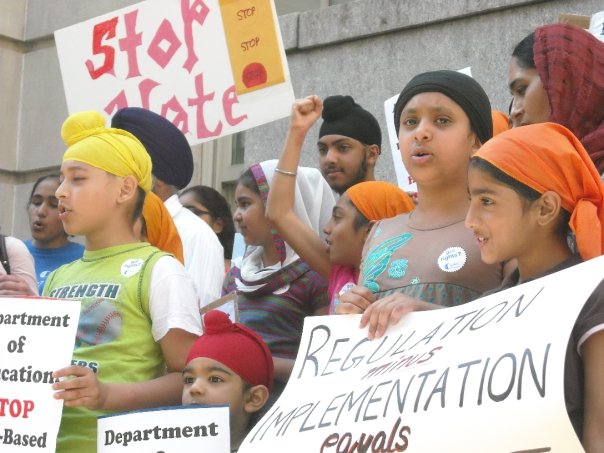
Last fall, the New York Department of Education passed a regulation in response to disturbing findings about the bullying that Sikh children face in schools. The regulation promised to define, track, and prevent bias-based harassment in NYC public schools. So after the first school year in which the regulation was in effect, how did the schools measure up?
The results were made public at a recent press conference by the Sikh Coalition and Sikh youth in NYC in front of the Department of Education’s headquarters. The Sikh Coalition teamed up with area organizations including the Coalition for Asian American Children and Families (CACF) and the Asian American Legal Defense and Education Fund (AALDEF), to release a report card grading the first year of the regulation’s implementation. Speakers at the press conference included representatives from Queens and Brooklyn schools and organizations such as the New York Civil Liberties Union (NYCLU), Desis Rising Up and Moving (DRUM), and Make the Road NY.
Problems remain, the report card shows. Based on the Sikh Coalition’s survey, there was no significant decline in the rate of harassment in the first year of the regulation’s implementation. [pg.9] Perhaps most disturbingly, out of all harassment reported by children, 16% was committed by a school official such as a teacher, school staff member, or security officer. [pg.12] In addition, after 90% of reported incidents of harassment to school officials, the school failed to properly follow protocol for investigation and follow-up. [pg.11]
For the full report card, click here.
“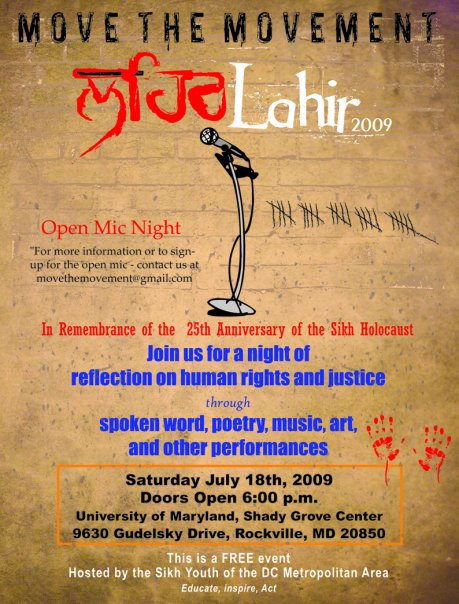 Never doubt that a small group of thoughtful, committed citizens can change the world. Indeed, it is the only thing that ever has.”
Never doubt that a small group of thoughtful, committed citizens can change the world. Indeed, it is the only thing that ever has.”
(Margaret Mead)
Last Summer, a small group of thoughtful, committed Sikh youth from the DC Metropolitan area came together to form “Lahir” (movement) – a conference organized and run by high school and college students to promote human rights awareness. There were three themes to the event. Educate, Inspire, and Act. The “Educate” segment consisted of a series of short presentations outlining the history of post-1984 human rights violations in Punjab, based on published documentation from Ensaaf. These presentations interspersed with videos of the victim’s families told the story of grave violations that occurred between 1984-1995 during the counter-insurgency movement – including torture, disappearances, and illegal cremations. The “Inspire” segment consisted of poetry, spoken word, and musical performances along the same theme. In the final portion, titled “Act”, participants broke out in to discussion groups and brainstormed ideas on how the Punjab case can be raised to a mainstream audience and reviewing what other communities have done to highlight their cause. Overall, the conference was a resounding success and launched several new initiatives.
This Summer, the Lahir team has re-assembled and Sikh youth activists and artists from all over the country will again descend upon the Nation’s Capital for Lahir 2009! This year’s format is an all-out ‘Open Mic’ with musical performances, displayed art, poetry, and spoken word. Trailers have been circulating around the internet, providing a glimpse of what to expect.
Co-blogged by Sundari and Camille.
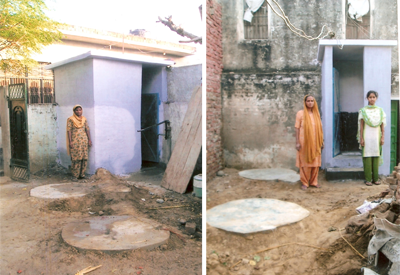 While many LangarHall moments are spent bringing awareness to adverse issues impacting our community, we believe it is equally important to highlight solutions to these problems. There are several people and organizations who are working to improve the social development and health of communities around the world. One example of a simple yet life changing initiative is a toilet. Yes, toilets. A facility taken for granted by many and something that over 2 million people around the world are in need of. The Punjab Lioness Toilet Foundation was created to provide awareness of communities in need of basic toilet and sanitation facilities,
While many LangarHall moments are spent bringing awareness to adverse issues impacting our community, we believe it is equally important to highlight solutions to these problems. There are several people and organizations who are working to improve the social development and health of communities around the world. One example of a simple yet life changing initiative is a toilet. Yes, toilets. A facility taken for granted by many and something that over 2 million people around the world are in need of. The Punjab Lioness Toilet Foundation was created to provide awareness of communities in need of basic toilet and sanitation facilities,
As a family initiative the Punjab Lioness Toilet Foundation wants to empower people to take action in providing basic toilet needs to less fortunate families in Punjab, India. The foundation was started in the memory of our late mother Pritam Kaur Bahia who passed away on November 18th, 2004. She was known as the “Sherni” a.k.a. Lioness. [link]
Founded by Mandip Kaur Sandher, one of the goals of the organization is to break the “toilet taboo,” which comes from people’s lack of comfort speaking about a subject which they consider dirty. This stigma is impacting global health and as a result, basic sanitation needs for hundreds and thousands of people around the world.
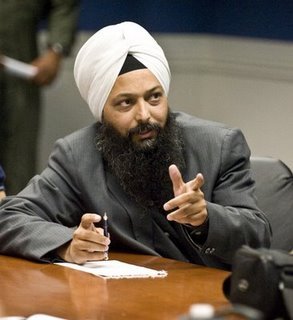 In a previous blog, I wrote about Jarnail Singh Journalist – Sikh Folk Hero. I also mentioned about his action as an act of rebellion that needs the support and institutions to become a revolution. In this post, he, himself, needs support.
In a previous blog, I wrote about Jarnail Singh Journalist – Sikh Folk Hero. I also mentioned about his action as an act of rebellion that needs the support and institutions to become a revolution. In this post, he, himself, needs support.
Unfortunately this week, as he flung his shoe demanding justice, he, himself, was victimized as he was terminated from the Hindi news daily Dainak Jagran, after more than a decade of service.
“As a journalist, I regret what I have done. It was not proper for a journalist to act in that manner. I was emotionally overtaken and exasperated, just like so many Sikhs are,” he said today.
“But I thought the chapter was closed because of the way the home minister had reacted and had accepted that not enough people (who were behind the killing of Sikhs in 1984) had been punished,” Jarnail said.
“Now I feel that I am being victimised, punished for raising my voice against the injustice of 1984 and the CBI’s and the government’s unwillingness to prosecute those who were responsible for it”, Jarnail said. He said he was even more resolute now.[link]
Last week, I wrote a wrap-up about the 10th Annual Jakara Movement Conference. Sikh Knowledge, a previously featured artist, wrote his thoughts on his blog.
However, an especially important post was written by Pashaura Singh Dhillon. For those that are regular langa(r)-eaders, then you need no introduction. In a post during last year’s presidential election, I introduced a Fresno Punjabi landmark – one of our many great poets.
At last week’s Jakara Movement Conference, Pashaura Singh delivered a powerful poem at the farewell banquet. On his own blog, he introduces the piece, written with a contemporary problem using a traditional Mirza meter. I quote at length:
I was invited to share a poem I wrote at the closing banquet of Jakara Movement. Jakara began in 2000 with a mission to call the next generation of Sikhs from all places, backgrounds and points of view to reflect on their past and prepare for the future. In 2009, they came together as the next generation of Sikhs to continue the process of empowering, engaging , and educating the Sikh community.
Kanwar Anit Singh Saini (Sikh Knowledge) and Kanwar Singh (Humble the Poet), two Canadian rappers and participants of 2009’s Jakara said it best. “1984 is all around us. It is happening in Rwanda. It is happening in Palestine. We should try to find connections with people who are also victims because then the minority becomes the majority.”
But I was not there to repeat what had already been reported or was going to be reported on this subject. As a poet I wanted to invite them to a different plane, whereby they not only take the message of what happened to the Sikhs 25 years ago but also what is happening all around the world today and how it relates to us all. A big picture where these compounded atrocities and excesses not only of humans on humans that are happening everyday but also collectively of humans on this planet Earth, which threatens its very survival. The victim of human’s inhumanity the Earth pleads with the princess of the Skies whose domain the fugitive from Earth is now so impatient to intrude. Without further adieu, here is “Umber Di Shehzadi De Naa: To the Princess of the Skies”

